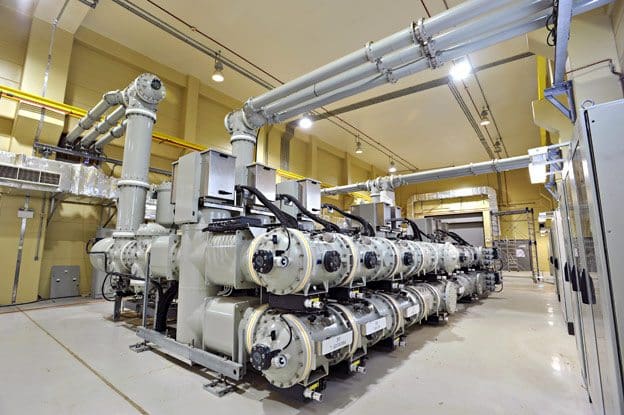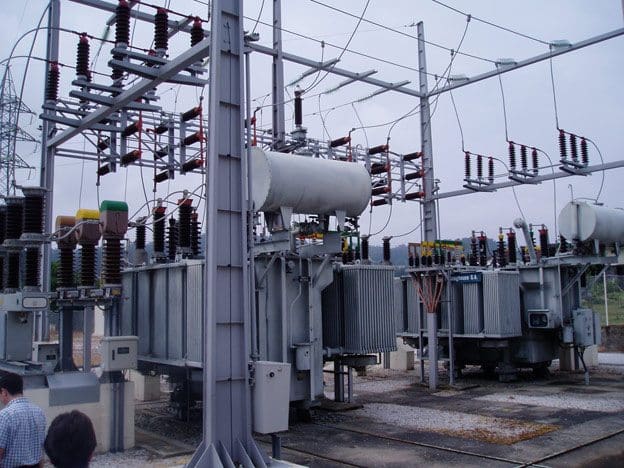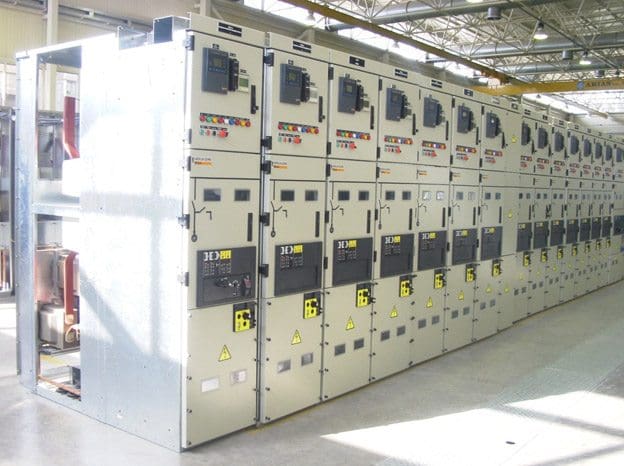Electrical substation
An electrical substation is an assemblage of electrical components including busbars, switchgear, power transformers, auxiliaries etc. These components are connected in a definite sequence such that a ckt. can be switched off during normal operation by manual command and also automatically during abnormal conditions such as short-circuit.

Basically an electrical substation consists of number of incoming ckt. and outgoing ckt. connected to a common Bus-bar systems. A substation receives electrical power from generating station via incoming transmission lines and delivers elect. power via the outgoing transmission lines.
Substation is integral part of a power system and form important links between the generating station, transmission systems, distribution systems and the load points.
Main tasks of major sub-stations in the T&D
Main tasks associated with major sub-stations in the transmission and ditribution system include following:
- Protection of transmission system.
- Controlling the Exchange of Energy.
- Ensure steady State & Transient stability.
- Load shedding and prevention of loss of synchronism. Maintaining the system frequency within targeted limits.
- Voltage Control; reducing the reactive power flow by compensation of reactive power, tap-changing.
- Securing the supply by proving adequate line capacity.
- Data transmission via power line carrier for the purpose of network monitoring; control and protection.
- Fault analysis and pin-pointing the cause and subsequent improvement in that area of field.
- Determining the energy transfer through transmission lines.
- Reliable supply by feeding the network at various points.
- Establishment of economic load distribution and several associated functions.
Types of substation
Classification
The substations can be classified in several ways including the following:
1 Classification based on voltage levels
e.g. : A.C. Substation : EHV, HV, MV, LV; HVDC Substation.
2 Classification based on Outdoor or Indoor
Outdoor substation is under open skv. Indoor substation is inside a building.
3 Classification based on configuration
- Conventional Air insulated outdoor substation or
- SF6 Gas Insulated Substation (GIS)
- Composite substations having combination of the above two
4 Classification based on application
- Step Up Substation – Associated with generating station as the generating voltage is low.
- Primary Grid Substation – Created at suitable load centre along primary transmission lines.
- Secondary Substation – Along secondary transmission line.
- Distribution Substation – Created where the transmission line voltage is step down to supply voltage.
- Bulk supply and industrial substation – Similar to distribution sub-station but created separately for each consumer.
- Mining Substation – Needs special design consideration because of extra precaution for safety needed in the operation of electric supply.
- Mobile Substation – Temporary requirement.
Important Notes:
Primary Substations receive power from EHV lines at 400KV, 220KV, 132KV and transform the voltage to 66KV, 33KV or 22KV (22KV is uncommon) to suit the local requirements in respect of both load and distance of ultimate consumers. These are also referred to ‘EHV’ Substations.
Secondary Substations receive power at 66/33KV which is stepped down usually to 11KV.
Distribution Substations receive power at 11KV, 6.6 KV and step down to a volt suitable for LV distribution purposes, normally at 415 volts.
Substation parts and equipment
Each sub-station has the following parts and equipment:
1 Outdoor Switchyard
- Incoming Lines
- Outgoing Lines
- Busbar
- Transformers
- Bus post insulator & string insulators
- Substation Equipment such as circuit-beakers, isolators, earthing switches, surge arresters, CTs, VTs, neutral grounding equipment.
- Station Earthing system comprising ground mat, risers, auxiliary mat, earthing strips, earthing spikes & earth electrodes.
- Overhead earthwire shielding against lightening strokes.
- Galvanised steel structures for towers, gantries, equipment supports.
- PLCC equipment including line trap, tuning unit, coupling capacitor, etc.
- Power cables
- Control cables for protection and control
- Roads, Railway track, cable trenches
- Station illumination system
2 Main Office Building
- Administrative building
- Conference room etc.
3 Switchgear and Control Panel Building
- Low voltage a.c. Switchgear
- Control Panels, Protection Panels
4 Battery Room and D.C. Distribution System
- D.C. Battery system and charging equipment
- D.C. distribution system
5 Mechanical, Electrical and Other Auxiliaries
- Fire fighting system
- Diesel Generator (D.G.) Set
- Oil purification system
Secondary Distribution

Distribution Substation












This has helped me to do the assignment
Really gave very nice knowledge
This is useful information, really appreciate all the explanation very interesting and could help build self enterprise for sub regional support and expansion of energy for domestic use, Thank you.
Really good for knowledge
Thank you Tanoy.
I want to learn this substation operation from u please help me to join
I am looking for regulations regarding personnel using our distribution substation rooms as break/lay down areas. The voltage is 12,470 coming into line side of gear and stepped down to 480/277 volt. Do you know of any OSHA, 70E, NEC, 70B, etc. codes or regulations that address this issue?
What I will do when whole substation will get tripp. Sir please tell step to charge ss
Dear Sir or Ma, am Electrical engineering be soon,because am still in one of our colleges here in Nigeria,Yaba College of Technology,level three as first degree and i work in one of Commnication in Nigeria Globamcom as Technician,please i need a job seriously from you sir or ma
Basic knowledge about sub station power house, 1 ckt & 2 ckt LILO, UG cable jointing , terminations, and all swichgear systems
Basic knowledge sub station power house
It really helped me to do my assignment.
excellence
wonderful materials for the budding engineers….thank you..